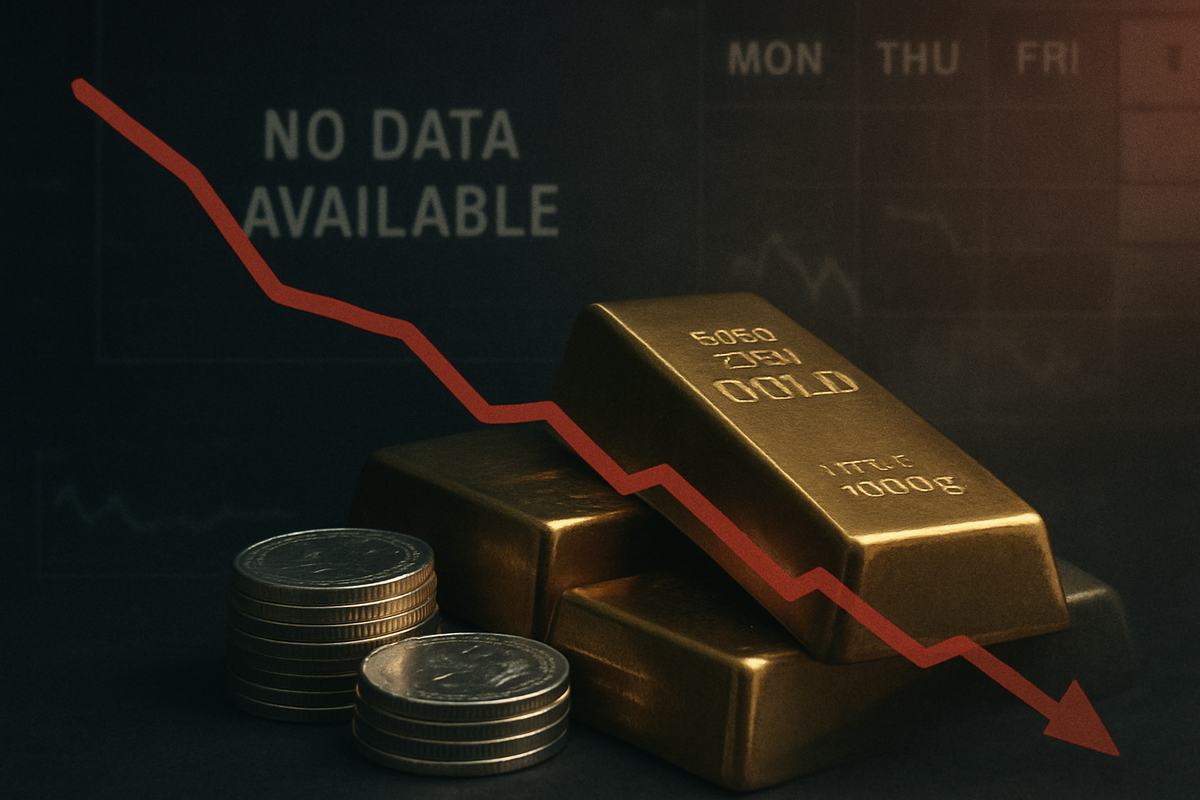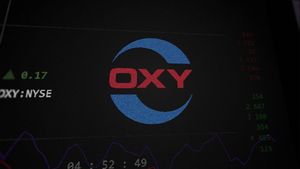
New York, NY – October 2, 2025 – Gold and silver prices, having recently scaled significant heights, are now retreating from their peaks as the financial markets grapple with an unprecedented blackout of official US jobs data. The ongoing US government shutdown, which commenced on October 1, 2025, has halted the release of critical economic indicators, most notably the highly anticipated September jobs report. This data vacuum has plunged markets into a state of heightened uncertainty, initially triggering a classic flight to safety into precious metals, but now leading to profit-taking and a recalibration of investor sentiment as the ambiguity persists. The immediate implications include increased market volatility, a scramble for alternative data sources, and amplified expectations for Federal Reserve interest rate cuts, all contributing to a complex and cautious trading environment.
The Unfolding Data Blackout: A Deep Dive into Market Disruption
The current market disruption stems directly from the US government's failure to agree on a funding bill, leading to a shutdown that began at midnight on October 1, 2025. This impasse has immediate and far-reaching consequences for economic transparency, as key federal agencies, including the Bureau of Labor Statistics (BLS), have ceased operations. Consequently, the September jobs report (Non-Farm Payrolls), originally scheduled for October 3, 2025, has been indefinitely postponed, along with other vital economic releases such as the Consumer Price Index.
The timeline leading up to this moment saw an initial surge in precious metals. As the prospect of a government shutdown loomed and the impending data blackout became clear, investors sought refuge in traditional safe-haven assets. Gold (COMEX: GC00) surged past $3,800 an ounce, briefly touching a record peak near $3,913 per ounce. Silver (COMEX: SI00) mirrored this ascent, reaching a 14-year high, approaching $48 per ounce. However, as the shutdown extended beyond its initial hours and the reality of prolonged data deprivation set in, these gains began to erode. As of October 2, 2025, gold is trading near $3,860 an ounce, about $35 below its recent peak, while silver has also experienced a noticeable dip after its rally. This retreat is largely a result of profit-taking by investors who capitalized on the initial surge, coupled with a broader market adjustment to the extended period of economic ambiguity.
Key players involved in this unfolding scenario include the US Congress, responsible for budget appropriations, and the Federal Reserve, which relies heavily on official economic data for monetary policy decisions. The absence of this data leaves the Fed "flying blind," complicating its ability to assess the health of the labor market and inflation. Initial market reactions have been mixed: while precious metals saw a dramatic rise and subsequent correction, the US dollar has weakened, and Treasury yields have tumbled. Surprisingly, the broader US equity market has shown some resilience, with major indexes posting gains on October 2, 2025, driven by strong performances in technology and healthcare sectors, suggesting that some investors are looking past the immediate political gridlock to focus on underlying corporate strengths and technological advancements like AI. The VIX volatility index, however, has surged, reflecting the underlying unease.
Corporate Fortunes in the Fog of Data Uncertainty
The current environment of economic data blackout and fluctuating precious metals prices creates a distinct landscape of winners and losers across various industries. Companies directly involved in the extraction and trading of gold and silver are on the front lines of this volatility.
Potential Losers: Mining giants like Barrick Gold (NYSE: GOLD) and Newmont (NYSE: NEM), while benefiting from the initial surge in gold prices, face increased uncertainty. Their stock performance is often highly correlated with the price of the commodities they extract. While higher prices generally boost their revenues, the current retreat from peaks, combined with prolonged market uncertainty, can lead to investor apprehension and potential stock price corrections. If the data blackout persists and fuels fears of a deeper economic downturn, industrial demand for silver, which has significant applications in electronics and solar panels, could also suffer, negatively impacting silver miners. Furthermore, companies that rely on stable economic indicators for their business planning, such as those in manufacturing or retail, may find it challenging to make informed decisions without reliable government data, potentially leading to delayed investments or hiring freezes. Financial institutions heavily invested in derivatives or complex market instruments tied to economic forecasts also face increased risk due to the lack of clear guidance.
Potential Winners: Paradoxically, the initial surge in gold and silver prices did provide a temporary boon for precious metals exchange-traded funds (ETFs) such as the SPDR Gold Shares (NYSEARCA: GLD) and the iShares Silver Trust (NYSEARCA: SLV). These funds saw increased inflows as investors sought safe-haven exposure. While the recent retreat may temper some of these gains, persistent uncertainty could continue to drive demand for these instruments as a hedge against broader market instability. Additionally, companies providing alternative data analytics or private economic surveys, such as the ADP National Employment Report, find themselves in a unique position. With official government data sidelined, their reports gain magnified importance, potentially increasing their visibility and influence. Technology companies, particularly those in resilient growth sectors like AI, have shown surprising strength, with companies like NVIDIA (NASDAQ: NVDA) continuing to perform well, as investors look for growth drivers beyond the immediate macroeconomic concerns. Their strong earnings and innovation narratives provide a counter-narrative to the broader economic anxiety.
Ultimately, the prolonged absence of official data could favor companies with strong balance sheets, diversified revenue streams, and less reliance on immediate macroeconomic clarity. Those that can adapt quickly to evolving market conditions and leverage private sector insights will be better positioned to navigate this period of opacity.
Wider Significance: A Precedent for Economic Transparency
The current US jobs data blackout is more than just a momentary blip; it represents a significant challenge to the foundations of economic transparency and market efficiency. This event underscores the market's profound sensitivity to reliable economic indicators, particularly in an era where data-driven decision-making is paramount. The absence of the September jobs report, a cornerstone for assessing the health of the US labor market, creates a void that reverberates across global financial systems.
This incident fits into broader industry trends highlighting the increasing interconnectedness of political stability and economic performance. Government shutdowns, while not unprecedented, rarely occur at a time when global economic conditions are already tenuous, amplifying their impact. The reliance on less comprehensive private-sector reports, such as the ADP National Employment Report—which, in a telling sign, reported a surprise drop in private-sector jobs for September—exposes the limitations and potential biases of such alternatives when official, comprehensive data is unavailable. This situation forces policymakers, including the Federal Reserve, to operate with incomplete information, increasing the risk of suboptimal monetary policy decisions, which could have long-term implications for inflation, employment, and economic growth.
The potential ripple effects extend to international trade and investment. Global investors, accustomed to the reliability of US economic data, may become more cautious about allocating capital, viewing the US market as less predictable. Competitors and partners abroad will also be left guessing about the true state of the US economy, potentially affecting their own strategic planning. Regulatory implications are also significant; this event may spur calls for mechanisms to ensure the continuity of essential data releases even during government impasses, or for increased funding and independence for statistical agencies.
Historically, market reactions to data gaps or government shutdowns have varied, but generally involve increased volatility and a flight to safety. For instance, past US government shutdowns have led to temporary market jitters and delays in economic reports, but the current scenario is exacerbated by the sheer magnitude of recent precious metal rallies and the existing global economic uncertainties. This event serves as a stark reminder of the fragility of market confidence when fundamental economic information is withheld, emphasizing the critical role of government institutions in maintaining market stability through transparency.
Navigating the Fog: What Comes Next
The path forward for financial markets, particularly for precious metals, will largely depend on the duration of the US government shutdown and the subsequent resumption of official economic data releases. In the short term, continued uncertainty is almost guaranteed.
Short-term Possibilities: If the government shutdown is resolved swiftly, a rebound in market confidence and a clearer economic picture could emerge. Gold and silver might see some initial profit-taking as the immediate safe-haven appeal diminishes, but their underlying support from potential Federal Reserve rate cuts could keep prices elevated. However, if the shutdown persists for an extended period, the prolonged data vacuum could lead to deeper market anxieties, potentially causing further corrections in precious metals as investors seek more definitive signals or alternative safe havens. The reliance on private data sources will continue, and any surprising figures from these reports could trigger disproportionate market reactions.
Long-term Possibilities: The long-term outlook for gold and silver remains tied to broader macroeconomic trends, particularly inflation expectations and central bank policies. The current data blackout, by fueling expectations of aggressive Fed rate cuts to support a weakening labor market, could provide a strong tailwind for non-yielding assets like gold. Lower interest rates reduce the opportunity cost of holding gold, making it more attractive. Moreover, if the government shutdown signals deeper political dysfunction, it could erode long-term confidence in the US dollar, further bolstering gold's appeal as an an alternative store of value.
Strategic Pivots and Market Opportunities: Companies and investors may need to adapt their strategies significantly. Diversification across asset classes and geographies will become even more crucial. Market opportunities may emerge in sectors less directly impacted by US economic data, or in companies with strong international exposure. Investors might also increasingly turn to quantitative models and AI-driven analytics that can process alternative data sources to gain an edge. Challenges include managing increased volatility and the difficulty of fundamental analysis without official statistics. Scenarios range from a quick resolution leading to a market correction and return to data-driven trading, to a prolonged impasse causing a more significant economic downturn and sustained safe-haven demand for precious metals.
A Crucial Juncture: Market Stability in Question
The current retreat of gold and silver prices from their recent peaks, triggered by the blackout of official US jobs data due to a government shutdown, marks a crucial juncture for financial markets. The event vividly underscores the profound sensitivity of global markets to economic transparency and the indispensable role of timely, accurate government statistics.
The key takeaway is the heightened fragility of market confidence when fundamental information is withheld. While the initial reaction saw a classic flight to safe-haven assets, the prolonged uncertainty has led to profit-taking and a recalibration of sentiment. This situation has amplified expectations for Federal Reserve interest rate cuts, as policymakers are left to navigate a weakening labor market with incomplete data, potentially leading to a more accommodative monetary policy that could, in the long run, support precious metals.
Moving forward, the market will remain fixated on developments in Washington regarding the government shutdown. Investors should watch for any signs of a resolution, as this will dictate the timeline for the resumption of official data releases. Beyond that, the performance of private economic indicators will gain outsized importance, and any divergence in their signals could further fuel volatility. The interplay between inflation concerns, central bank actions, and geopolitical stability will continue to shape the trajectory of gold and silver. This period serves as a potent reminder that in the absence of clear economic signals, political stability and institutional reliability become paramount in influencing investor behavior and market direction.
This content is intended for informational purposes only and is not financial advice





